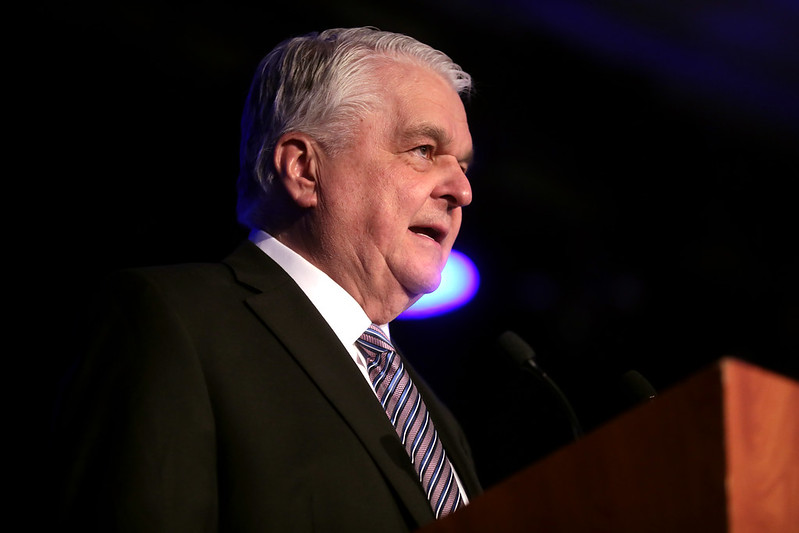Nevada’s June 9 Primary in the Wake of the Coronavirus
The state’s early decision to transition to an all vote-by-mail primary election seems prescient.

Published by The Lawfare Institute
in Cooperation With

Lawfare is partnering with the Stanford-MIT Healthy Elections Project to produce a series on election integrity in the midst of the coronavirus crisis. The Healthy Elections Project aims to assist election officials and the public as the nation confronts the challenges that the coronavirus pandemic poses for election administration. Through student-driven research, tool development, and direct services to jurisdictions, the project focuses on confronting the logistical challenges faced by states as they make rapid transitions to mail balloting and the creation of safe polling places. Read other installments in the series here.
In response to the rising threat of the coronavirus, Nevada embraced a vote-by-mail system for its primary election that was unprecedented in the state’s history. On March 24, relatively soon after the pandemic began, the state’s Republican secretary of state announced that the June 9 primary election would be administered almost entirely by mail. Nevada’s counties mailed ballots to all active registered voters, and 98.4 percent of the votes cast in the primary were cast by mail ballot.
On Aug. 3, following the primary, Nevada passed Assembly Bill 4, a sweeping election reform bill that extends all-mail elections to the November general election and addresses several of the issues that surfaced in the June 9 primary. The next day, President Trump sued the state seeking to halt the plan.
What can be learned from Nevada’s first all-mail election on June 9? The early decision to transition to an all vote-by-mail primary election seems prescient. By the week of the election, Nevada was experiencing its highest coronavirus spike yet. The distribution of ballots by mail gave most voters a way to vote without having to risk coronavirus exposure in potentially crowded polling places. But there were glitches. About 223,000 ballots in Clark County were returned undelivered, meaning that a significant number of voters never received a ballot in the mail. Of those who did receive ballots, some were confused about the mail-voting process, contributing to the rejection of more than 10,000 returned ballots—more than 2 percent of the total vote—on account of ballot defects.
Additionally, the expansion to all-mail voting came at the cost of access to in-person voting. To reduce the number of large gatherings, Nevada also reduced the number of in-person voting locations. Most of Nevada’s counties had only one polling location for the entire county. But thousands of voters chose to vote in person, despite increased access to mail voting. This led to long lines at the polls and delayed reporting of election night results.
Three key lessons can be gleaned from Nevada’s primary election. First, access to in-person voting is a necessary backstop to a vote-by-mail election. Despite Nevada’s announcement of an all vote-by-mail election, thousands of people chose to vote in person instead. The long lines at the polls illustrate the need to maintain an in-person voting infrastructure regardless of the widespread availability of vote by mail. Second, the general public needs to be better educated on the vote-by-mail process. The thousands of rejected ballots from Nevada’s primary election for ballot deficiencies underscore a lack of familiarity with the mail voting process. And third, both voters and counties in the state need to do a better job of maintaining accurate and current voter addresses in the registration records to avoid high volumes of undelivered ballots.
Our Nevada report dated July 10, before the August primary, is available here.
The Lay of the Land
Voter turnout for Nevada’s June 9 primary election, held almost entirely by mail, was one of the highest in state history for a primary—491,654 votes were cast, nearly 30 percent of all registered voters. Races in the primary included Nevada’s four congressional seats, two state Supreme Court seats, three state senate seats, 23 state assembly seats, and many local races.
In normal circumstances, Nevada voters can either register to receive an absentee ballot or vote in person. To obtain an absentee ballot, a voter simply completes and submits a form to the county in which they are registered to vote. No excuse is required. The voter also has the option to register as a permanent absentee voter, in which case the state will mail the voter an absentee ballot for every election.
For the June 9 primary election, however, the secretary of state, together with all 17 Nevada county election officials, decided unanimously to conduct the primary election by all-mail ballot, with limited exceptions for in-person voting. The rules for voting by mail in that primary were as follows:
- In order to receive a mail-in ballot, voters were required to register to vote by May 21.
- All “active” registered voters were automatically sent a mail-in ballot and an official postage prepaid return envelope.
- In Clark County only, the state’s most populous county, inactive registered voters received ballots as well as active registered voters—an accommodation made in response to a lawsuit brought against the county. An inactive voter is one who has not voted in the past two general elections and did not respond to postcards from the board of elections within 30 days to confirm their mailing address. (Mailing ballots to inactive voters is a hotly contested political issue nationwide, related to a partisan battle about whether inactive voters should be “purged” from voter rolls.)
- Mail-in ballots were required to be submitted in the official ballot return envelope.
- Each ballot included a barcode associated with an individual voter and could not be replaced if lost.
- Voters were required to sign the official ballot return envelope in order for their signatures to be verified against signatures on file. In the event of a discrepancy, voters were contacted by mail and afforded an opportunity to “cure” their signature by June 16 to have their vote counted.
- Mail-in ballots had to be postmarked by election day (June 9) and received within seven days after the election (June 16).
- For voters who were unable to mail their forms, or who simply preferred to drop them off in person, dedicated physical locations were provided for returning ballots. In Clark County, mail-in ballots could also be picked up at voters’ homes by trained “field registrars of voters.”
To support the transition to mail-in voting, the state received $4.5 million in funding through the federal CARES Act to help pay for the Nevada primary. The money helped to purchase ballot-counting equipment, cover the cost of printing ballots, and pay for the state’s voter education campaign. Subsequently, the state received an additional $148 million in CARES Act funding to help cover general expenses due to the public health emergency.
Voting Patterns
Nearly all of Nevada’s 2020 primary voters decided to take advantage of the entirely vote-by-mail primary. Overall, 98.4 percent of votes (or 483,788 ballots) were cast by mail in the primary. By comparison, only 7.9 percent of votes (or 26,054 ballots) were cast by mail in Nevada’s 2018 primary.
The all-mail primary also propelled an ongoing trend in the state of increased voter turnout. According to the secretary of state, total voter turnout for the June 9 primary was 480,885 votes as of June 23, which represented 29 percent of registered voters. This significantly exceeded the secretary of state’s estimate that 420,000 ballots would be cast in the primary. It was also a larger turnout than in Nevada’s previous two primaries, in terms of both the absolute number of voters and the percentage of registered voters who participated. Only 329,863 votes were cast in Nevada’s 2018 primary, representing 22.87 percent of registered voters. And just 18.51 percent of registered voters cast ballots—240,181 in total—in Nevada’s 2016 primary.
Despite encouraging all Nevadans to vote by mail, Nevada also provided for limited in-person polling sites both before and on Election Day. In-person voting was recommended only for those who registered online after the May 21 registration deadline to receive a mail-in ballot, voters who required same-day voter registration and voters with disabilities who were in need of assistance. A total of 7,866 people voted in person.
Primary Postmortem
Nevada’s early decision to convert its primary to an almost all mail election afforded it time to prepare. The state launched a focused effort to inform voters about the mail voting process. The Nevada secretary of state conducted a public information campaign and built a dedicated website (an archived version of which can be found here) to inform voters about the mail voting process. Ballots were mailed out early to help avoid postal service delays. Ballot drop-off locations were also provided for voters who preferred to drop off their ballots in person. And once ballots were cast, Nevada even provided online tracking for the ballots to enable voters to confirm that their ballots were counted.
While the state’s mail voting largely performed as planned, a few significant issues surfaced. In Clark County, one in five ballots were returned as undeliverable by the U.S. Postal Service (USPS)—about 223,000 of the 1.3 million mailed ballots. Of these, 58 percent were mailed to inactive voters—that is, voters who failed to maintain their address with the county but remain registered to vote. But 42 percent of the returned ballots— over more than 93,000—were mailed to active voters. This likely includes many voters who moved after confirming their address on file but before the election.
Additionally, a total of 10,799 ballots were rejected by election officials statewide. Most were rejected because they were missing signatures or because the county determined that the signatures did not match the signature in the voter’s registration file. Initially, 12,366 ballots were rejected for these signature defects, but after the grace period to cure the signature defect, 6,749 ballots remained uncured and were ultimately rejected. Another 4,050 ballots were rejected because, among other reasons, the return envelopes contained multiple ballots or no ballot, or bore postmarks after the June 9 deadline. That this number of ballots was rejected for deficiencies is not surprising given that many mail voters were first-time mail voters, but it highlights the need for better voter education on the details of mail voting, such as signature requirements and the opportunity to cure errors.
The relatively smooth experience of voting by mail for many people was counterbalanced by the inconveniences faced by voting in person. Part of the reason Nevada switched to an all-mail primary election was to reduce the number of in-person voting sites in an effort to mitigate the potential spread of the coronavirus. In 15 of Nevada’s 17 counties, only one in-person polling place was available. Clark County, home to 74 percent of the state’s population, offered three locations, down from 172 in the 2018 primary and 265 in the 2016 primary. Nye County offered only two locations.
But despite the significant reduction in the number of in-person voting locations, a higher number of voters than expected still chose the in-person option. Some voters simply never received a ballot in the mail—in some cases, because they missed the registration deadline or moved without updating their address—and chose to vote in person instead. Some voters worried about people stealing their mail. Other voters had concerns about fraud. Regardless of their reasons, a total of 7,866 people decided to vote in person.
Of those who voted in person, slightly more than a thousand took advantage of Nevada’s early voting laws, which allow in-person voting at select polling places in the weeks before Election Day. Because of the pandemic, and the shift to vote by mail, early voting was “extremely limited” in 2020, contributing an estimated 15 percent of in-person votes, compared to 52 percent in the 2018 primary.
On Election Day, the number of individuals voting in person, combined with the reduction in polling locations, led to long lines for some voters. For example, Steve Connolly, who bills himself as the longest-running Elvis impersonator in Las Vegas, said he arrived to vote at 6:45 p.m. but had to wait in line until 3:09 a.m. to cast his vote. This was approximately eight hours after the polls were scheduled to close. NBC News Las Vegas also reported that voters were waiting in line for three hours to vote. Voters posted on social media about the unusually long lines, with one voter sarcastically asking if this was punishment for choosing to vote in person.
The change to a predominantly vote-by-mail system also resulted in delays in the vote count. Because of the long lines that resulted from the reduced number of polling locations, the results for in-person voting were delayed by hours. Further, the additional week provided for voters to cure missing or defective signatures on ballots delayed the election count process even more. This delay in reporting led to some late surprises in the voting results. In a state senate race between Roberta Lange, the former head of Nevada’s State Democratic Party, and Ellen Spiegel, Spiegel appeared to be in the lead, but when the final count came in two weeks after Election Day, Lange came away with a close victory.
Legal Challenges to the Vote-by-Mail Primary
Two major lawsuits were filed in response to the decision to hold an almost all-mail primary election, one by several Democratic organizations seeking to expand voter access, and the other by a conservative voting rights group seeking to impede what it alleged was a risk of voter fraud. And on Aug. 4, the Trump campaign filed an additional lawsuit to challenge the state’s new law that provides for an all-mail election in November.
The first suit, filed on April 16 by the Nevada State Democratic Party, Democratic National Committee and other organizations in Clark County, sought to expand voter access in two ways. First, it sought to require the county to mail ballots to all registered voters—active as well as inactive in Clark County. Second, it sought to force the county to increase the number of polling stations. The plaintiffs alleged that a solely vote-by-mail primary would exacerbate voter disenfranchisement due to two state statutes: one that prohibits a person from dropping off another voter’s ballot (a practice known as “ballot harvesting”) and a second that allows election officials to reject ballots with signatures that do not match the voter’s signature on file.
On May 5, the plaintiffs dropped the suit after Clark County election officials agreed to change certain voting procedures. Specifically, the county agreed to expand in-person voting from one site to three, to have two election officials review all mismatched signatures before disqualifying a ballot, to allow voters to “cure” their signatures before disqualifying a ballot, and, finally, to train 20 “field registrars of voters” to collect sealed ballots from voters at their homes.
The second lawsuit, filed on April 21 by the conservative election integrity group True the Vote in the U.S. District Court for the District of Nevada, sought a preliminary injunction to halt the state’s plan for an all-mail primary election. The suit alleged that an all-mail election increases the risk of voter fraud and therefore violates the plaintiffs’ right to vote as a result of vote dilution. The court twice rejected the request for a preliminary injunction for lack of a particularized injury. And the judge wrote that even if the plaintiffs could show standing, the state’s interests in protecting voters’ health and participation in the election during a pandemic “outweigh any burden on Plaintiffs’ right to vote, particularly when that burden is premised on a speculative claim of voter fraud resulting in dilution of votes.” Additionally, the court held that the secretary of state had the legal authority to implement the all-mail election. The case was dismissed as moot on July 31.
The Trump campaign’s recent lawsuit responds to legislation passed after the primary. In the days after June 9, Nevada had no plans to repeat the all-mail election process for the general election in November. And not everyone agreed on the appropriate course. The Clark County Registrar of Voters recommended automatically sending mail-in ballots to registered voters again and increasing the number of in-person voting sites from three to 35. Republican State Assemblyman Chris Edwards, by contrast, supported in-person voting, arguing that mail-in voting may lead to voter fraud. “There is no reason to do mail-in ballots,” Edwards said. “We can open enough polls. We can have social distancing if they want. If Walmart and Costco and all of these large stores can do business in this pandemic, we can do voting.”
On Aug. 3, Nevada’s governor signed Assembly Bill 4, a sweeping election reform bill that, among other things, commits Nevada to an almost exclusively vote-by-mail format for November’s general election and any future election during a statewide emergency or disaster directive declared by the governor or resolution of the state legislature. The law, passed along party lines, requires counties to automatically mail a ballot to active registered voters and allocates $3 million for the preparation and distribution of mail ballots.
The new law also requires the state to provide a minimum number of polling places for in-person voters, on Election Day and during early voting (the latter for cities that offer it). The minimum number of required polling places and vote centers depends on the population of the county. A county with a population of 700,000 or more, for example, is required to have a minimum of 35 polling places for early voting, and 100 vote centers on Election Day. A county with a population of between 100,000 and 700,000 must have at least 15 polling places for early voting and 25 vote centers on Election Day.
In contrast to the state’s prior prohibition on so-called ballot harvesting, Assembly Bill 4 allows elderly and disabled voters to seek assistance from anyone to fill out and deliver their ballot. And the law sets new procedures and standards for reviewing and verifying signatures and requires the state to notify voters of signature defects. The bill also addresses vote-count delays by allowing vote counting boards to start counting mailed ballots 15 days before Election Day instead of the previously specified four working days.
“It is extremely important to me that our citizens do not have to decide between their health and their right to vote,” Governor Steve Sisolak said. Even before Assembly Bill 4 was signed into law, President Trump promised to sue Nevada. He accused the governor of “using Covid to steal the state.”
On Aug. 4, the day after Sisolak signed the bill into law, President Trump’s reelection campaign sued Nevada’s Republican secretary of state in the U.S. District Court for the District of Nevada. The suit seeks to enjoin the implementation of the new law, arguing that it “upends Nevada’s election laws and requires massive changes in election procedures and processes and that it makes voter fraud and other ineligible voting inevitable.” The Trump campaign claims that the bill unconstitutionally extends the deadline for Election Day, due to a provision that allows ballots with unclear postmark dates to be accepted up to three days after the day of the election. The complaint says that most mail carriers deliver postmarked mail within one to two days and that the law “effectively extends the congressionally established Election Day.” Separately, the Trump campaign also questioned the ability of Nevada to handle the volume of election mail due to recent funding cuts at the USPS.
Summary
Assembly Bill 4 addresses many of the pandemic-related challenges that Nevada faced in its primary in preparation for the November general election. It provides for ballots to be mailed to all active registered voters, but not to inactive registered voters, so the rate of ballots returned as undeliverable should decrease in November. It also increases the number of in-person voting options in order to reduce lines and health risks for those who choose to vote in person. The bill provides funds for mailing out ballots, standardizes signature verification procedures, enables voters to cure defects and decreases the likelihood of vote-count delays by allowing the count to start sooner. Time will tell if the law survives Trump’s legal challenge.
With the passage of Assembly Bill 4, Nevada now has an opportunity to address a few remaining challenges:
- To better educate the general public about its now-codified new mail-voting procedures. The number of ballots rejected during the primary election underscores the need for better voter education. To that end, the USPS is proactively conducting outreach with state and local election officials and secretaries of state to assist in educating the public as they prepare to vote by mail.
- To improve its voter registration records to reflect the current addresses of voters. This is likely a combined effort on the part of counties and voters, who could be better educated on the importance of maintaining an accurate address on file, for example, when they move.
- To address feared USPS backlogs due to recent funding cuts. Opponents of mail voting are questioning whether the USPS can handle the volume of ballots in Nevada. However, the Washington Post reported that Nevada was one of only four states not warned by the post office about possible issues with mail-in balloting.








